#buddha statue online
Explore tagged Tumblr posts
Text
Shopping at Satguru’s: A Guide to Finding the Best Home Decor Pieces
Shopping for home decor, art, and unique gifts is always an exciting experience, especially when you know exactly where to go. If you’re in Mumbai, Satguru’s is the ultimate destination for all things aesthetic and artistic.
Whether you’re searching for exquisite Satguru paintings, stylish frames, or premium-quality Satguru home decor, this store has it all. In this guide, we’ve compiled some of the best finds at Satguru’s store, ensuring you make the most out of your shopping experience.
The Best Home Decor Pieces to Look for at Satguru’s
1. Satguru Paintings—Blue Ghaat Panel—B by Bishwaranjan

Shop Now
One of the biggest highlights of the Satguru store is its impressive collection of Satguru paints. A standout piece is the Blue Ghaat Panel—B by Bishwaranjan, which beautifully captures the essence of Indian landscapes with a contemporary touch. This painting is perfect for adding a serene and sophisticated vibe to your home or office space.
2. Satguru Frames—Panchmukhi Hanuman on Oval Frame
Shop Now
Frames can make a huge difference in how artwork and photographs are displayed. Satguru frames are known for their superior quality and unique designs. One must-have piece is the Panchmukhi Hanuman on Oval Frame. The intricate detailing of Hanuman Ji’s five faces in an elegant oval frame makes it a perfect addition to your home temple or sacred space.
3. Satguru Home Decor—Sarafay Ecomix Vase With Cane
Shop Now
Decorating your home is an art, and Satguru’s home decor offers some of the finest pieces to enhance any space. For those who love earthy, minimalist decor, the Sarafay Ecomix Vase With Cane from the Satguru home decor collection is a must-have. It beautifully blends contemporary aesthetics with traditional craftsmanship, making it an exquisite piece in your home.
4. Satguru Gift Shop – Designer Deer Table Clock
Shop Now
One of the most exquisite finds is the Designer Deer Table Clock, an elegant combination of utility and decor. It’s an intricately designed clock perfect for gifting during Diwali, house-warming parties, or corporate events. However, if you want to explore more options, you can reach out to the friendly and knowledgeable staff at Satguru’s and get help to find the perfect gift.
5. Satguru Arts—Buddha Wall Hanging with LED

Shop Now
The Satguru Arts is a collection of the finest pieces to decorate any space. The Buddha Wall Hanging with LED is a blend of spirituality and modern elegance. Inspired by the teachings of Lord Buddha, this piece radiates positivity and peace, making it an ideal decor item for meditation corners, living rooms, or even workspaces.
Why Shop at Satguru’s?
Satguru’s is synonymous with luxury and quality, featuring the best pieces from all across India for the last 70 years. Located in Bandra, the Satguru store is a well-known hub for art lovers and interior enthusiasts. The store offers a diverse range of products, including wall art, paintings, home decor, souvenirs, spiritual idols, and much more. To spruce up your living space or find a meaningful gift, Satguru’s is one of the best places to shop.
Finishing Up
Shopping at Satguru’s is an experience in itself. Whether you’re looking for timeless paintings, elegant frames, or stylish home decor items, at Satguru’s, you’ll find only premium-quality products that add beauty and charm to any space. So the next time you’re searching for home decor items, visit the Satguru Bandra store or visit the website online—you never know what hidden gems you might discover!
0 notes
Text
Embracing Serenity: The Timeless Elegance of Gautam Buddha Statues

In the hustle and bustle of modern life, finding moments of peace and tranquility is essential for maintaining balance and harmony. One timeless symbol that embodies serenity and wisdom is the Gautam Buddha Statue. Crafted with meticulous detail and imbued with profound spiritual significance, these statues serve as both decorative pieces and powerful reminders of inner peace. At The Stone Studio, we celebrate the enduring allure of Gautam Buddha Statues and invite you to explore the beauty they bring into our lives.
Exploring the Essence: Gautam Buddha, also known as Siddhartha Gautama, was a spiritual teacher who founded Buddhism. His teachings on mindfulness, compassion, and enlightenment continue to inspire millions around the world. The Gautam Buddha Statue captures the essence of his teachings, depicting him in various poses, each with its own symbolic meaning.
Whether it's the serene expression of the meditating Buddha or the compassionate gaze of the blessing Buddha, each statue invites us to reflect on our own journey towards inner peace and enlightenment. The craftsmanship involved in creating these statues is truly remarkable, with artisans meticulously sculpting every curve and contour to perfection.
Bringing Home Tranquility: In today's fast-paced world, it's easy to feel overwhelmed and disconnected from our inner selves. A Gautam Buddha Statue serves as a tangible reminder to pause, breathe, and reconnect with our inner tranquility. Placing one of these statues in your home or meditation space can create a sacred atmosphere conducive to mindfulness and introspection.
At The Stone Studio, we offer a wide selection of Gautam Buddha Statues to suit every taste and style. Whether you prefer a classic stone sculpture or a modern interpretation in metal or resin, we have something to complement any decor. Our online store makes it easy to browse and purchase your perfect Buddha statue from the comfort of your own home.
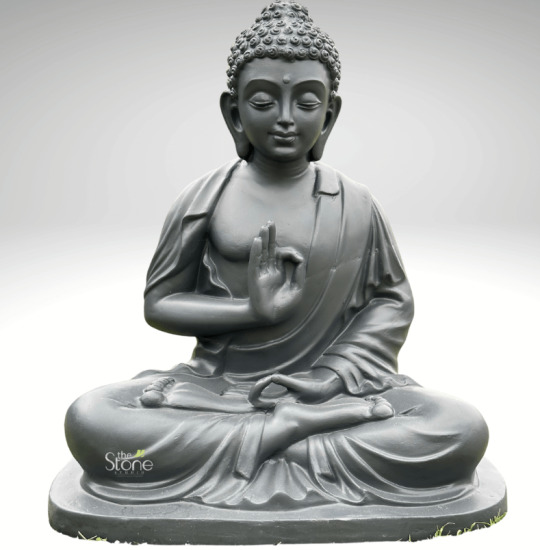
Embracing Mindful Living: In addition to their aesthetic appeal, Gautam Buddha Statues also serve as powerful symbols of mindful living. By incorporating these statues into our daily lives, we are reminded to cultivate qualities such as compassion, gratitude, and acceptance. Whether placed in a meditation corner, garden, or living room, the presence of a Buddha statue can inspire us to live with greater awareness and intention. In a world filled with distractions and noise, the timeless elegance of Gautam Buddha Statues offers a beacon of tranquility and wisdom. At The Stone Studio, we are proud to celebrate the beauty and significance of these statues, inviting you to embrace their transformative power in your own life. Whether you're seeking a decorative accent for your home or a spiritual symbol to guide your journey, a Gautam Buddha Statue is sure to inspire serenity and enlightenment wherever it resides. Visit our online store today and bring home a piece of timeless elegance.
0 notes
Text

Experience serenity through our Buddha statue collection. Buy Buddha statues online in India from Chokhi Dhani Kalagram and let the tranquil presence of these exquisite sculptures inspire mindfulness and harmony in your surroundings.
0 notes
Text
Buy Ganesha Laxmi Idol & Krishna Radha Idol for Prosperity Spiritual Bliss
Invite blessings of abundance and prosperity into your home with a Ganesha Laxmi idol. This divine union represents Lord Ganesha, the remover of obstacles, and Goddess Lakshmi, the bestower of wealth and fortune.
A Ganesha Laxmi idol, meticulously crafted with reverence, symbolizes the harmonious combination of wisdom and material abundance. Displaying this idol in your home creates an auspicious ambiance that attracts prosperity and success.

Embrace the divine presence of Ganesha and Lakshmi as you seek their blessings for a fulfilled and prosperous life. Let their energy guide you towards abundance, harmonious relationships, and spiritual fulfillment. Embrace the divine union and experience the transformative power of Ganesha Laxmi in your life.
Discover the epitome of divine love and devotion with a Krishna Radha idol. This sacred representation of Lord Krishna and Radha signifies the eternal bond between the divine and the devotee.
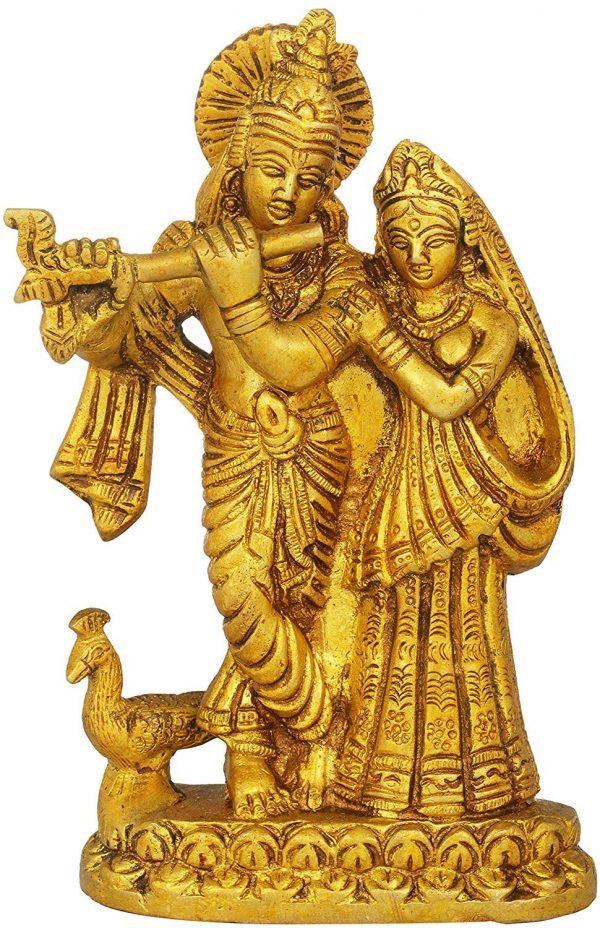
Crafted with exquisite artistry, a Krishna Radha idol captures the essence of their divine love story. The playful and enchanting presence of Krishna, along with the devotion and beauty of Radha, creates an atmosphere of spiritual bliss.
By welcoming a Krishna Radha idol into your home, you invite the energy of unconditional love, harmony, and spiritual union. Immerse yourself in their divine grace, experience the blissful devotion, and let their divine love guide your spiritual journey.
#krishna radha statue#krishna radha idol#shruti box online#brass buddha statue#buddha statue online#lakshmi statue#lord krishna idol#lord ganesha statue#lord ganesha idol#tibetan singing bowls#ganesha laxmi idol
1 note
·
View note
Text
Brass Buddha Statue for a Peaceful and Serene Home Atmosphere - Lalis Kart
Brass Buddha Statue: A Timeless Symbol of Peace and Tranquility for Your Home
A Brass Buddha statue is a beautiful and meaningful addition to any home, creating a peaceful and serene atmosphere. Whether you are looking to enhance your living room, bedroom, or meditation space, the presence of a Buddha statue made from brass exudes tranquility and harmony. The brass finish adds a touch of elegance, making it a perfect blend of spirituality and artistry. By placing this stunning piece in a central area of your home, you not only invite positivity and balance but also elevate the decor with a piece of timeless craftsmanship.

Handicraft Items Online: A Treasure Trove of Unique Home Decor
In addition to the stunning beauty of a Brass Buddha statue, there are many other handicraft items online that can enhance your home’s aesthetic. Indian handicrafts, in particular, have a rich history and cultural significance, offering an array of decorative items for living room spaces that provide both style and character. Websites like Lalis Kart offer a wide selection of handcrafted pieces, allowing you to buy coasters online, Toran for home decoration, and other unique decorative items for your home with ease.
Indian handicrafts online shopping has made it easier than ever to access high-quality products from skilled artisans. Whether you're looking for a traditional brass Buddha statue or other decorative items, shopping online gives you access to a vast collection of home decor options. These handicraft items not only enhance your home’s aesthetic but also tell a story of rich cultural heritage.
Why Choose a Brass Buddha Statue for Your Home
A Brass Buddha statue can bring numerous benefits to your home, making it an excellent choice for anyone looking to create a peaceful and balanced environment. Some of the key reasons to consider a Brass Buddha statue for your space include:
Symbol of Peace and Tranquility: The Buddha is known for embodying peace, meditation, and enlightenment. A Brass Buddha statue serves as a reminder of mindfulness and inner calm. Its serene expression and thoughtful design can transform any room into a space for relaxation and reflection.
Timeless Aesthetic: Brass has a classic appeal that never goes out of style. The warm golden hue of a Brass Buddha statue adds elegance and sophistication to any home decor. Whether you place it in your living room, meditation room, or study, it will enhance the surroundings with its timeless beauty.
Positive Energy: It is widely believed that Buddha statues bring positive energy and good luck. By placing a Brass Buddha statue in your home, you invite a sense of harmony, balance, and spiritual well-being into your environment.
Durability: Brass is a durable material that withstands the test of time. This ensures that your Brass Buddha statue will remain a cherished piece in your home for years to come, retaining its beauty and meaning throughout.
Perfect for Meditation and Yoga Spaces: A Brass Buddha statue is particularly beneficial for creating a peaceful atmosphere in meditation or yoga rooms. Its calming energy helps to promote focus and mindfulness, supporting your spiritual practices.
How to Incorporate a Brass Buddha Statue in Your Home Decor
Integrating a Brass Buddha statue into your home decor is easy and versatile. Here are some ideas on where and how to display your Brass Buddha statue:
Living Room: Place the statue on a central table or shelf to serve as a focal point. Its serene presence will encourage relaxation and calmness for anyone in the room.
Bedroom: Position the Brass Buddha statue on a nightstand or shelf, where its peaceful energy can influence a restful sleep environment.
Meditation or Yoga Space: A Brass Buddha statue is the perfect companion for your meditation corner or yoga space. Set it on an altar or small table to enhance the spiritual vibe of your practice area.
Entryway: Place the statue near your entrance to greet visitors with a sense of peace and positive energy as they enter your home.
Where to Buy Brass Buddha Statue and Other Handicraft Items Online
When it comes to purchasing a Brass Buddha statue and other unique home decor items, Lalis Kart is a trusted name. They offer a wide selection of handcrafted decorative items, including beautiful Brass Buddha statues, perfect for adding serenity and style to any home. By shopping at Lalis Kart, you can easily find unique pieces, from Toran for home decoration to handcrafted coasters and other decorative items for the living room.
Online shopping has made it more convenient than ever to access quality handicrafts in Singapore and beyond. Whether you're looking for traditional Indian handicrafts or contemporary decor pieces, Lalis Kart offers an impressive collection to suit various tastes and styles.
Conclusion: Enhance Your Home’s Peaceful Atmosphere with a Brass Buddha Statue
In conclusion, a Brass Buddha statue is not just a piece of decor but a symbol of peace, mindfulness, and serenity. Its timeless beauty and calming energy can transform your home into a sanctuary of tranquility. Lalis Kart provides an excellent selection of Brass Buddha statues and other handicraft items online, ensuring you find the perfect piece for your home. Whether you're looking to buy a Brass Buddha statue, Toran for home decoration, or other decorative items, Lalis Kart’s online platform offers convenience and variety.
By incorporating these items into your home, you can create a harmonious atmosphere that nurtures relaxation and positivity. For a complete home decor experience, you can also explore their range of handicraft items online and enjoy the best of Indian handicrafts online shopping. And if you're looking to add more functionality to your home, don't forget to check out options like buying coasters online to complement your decor!
#Brass buddha statue#Handicraft items online#Indian handicrafts online shopping#Handicrafts in singapore#Decorative items for living room#Jewellery online singapore#Buddha statue for home#Toran for home decoration#Brass pooja thali set online#Brass diyas online
0 notes
Text

Serenity in Style: Vitarka Mudra Buddha Statue by Royaloak
Add a touch of serenity and elegance to your home with the Royaloak Polyresin Vitarka Mudra Buddha Statue. This beautifully crafted statue exudes peace and wisdom, making it a perfect centerpiece for your living room, meditation space, or office. The intricate detailing and the vibrant color of the robe bring the statue to life, creating a calming ambiance wherever it is placed.
Discover more exquisite Buddha statues like this one at Royaloak, where you can find a variety of options to enhance your home decor with spiritual charm and artistic beauty.
#buy sofas online#buy living room furniture online in india#furniture store near me#online furniture store#royaloak#chairs online#sofas#buy online furniture#furniture#online furniture#buddha statue
0 notes
Text
Bring Positivity with a Buddha Statue For Your Home
Bring Positivity to Your Home with a Buddha Statue
A Buddha statue for home is not just a decorative piece but a symbol of peace, wisdom, and tranquility. Incorporating a Buddha statue into your home decor can significantly enhance the atmosphere, bringing a sense of calm and positivity. Whether you're looking to create a serene meditation space or simply wish to add a touch of spiritual elegance to your living environment, a Buddha statue is a timeless choice. Online platforms like Lalis Kart offer a wide range of Buddha statues that cater to various styles and preferences, making it easy to find the perfect fit for your home.

Enhancing Your Space with Decorative Items for Living Room
In addition to a Buddha statue, integrating other decorative items for the living room can further enrich the ambiance of your home. Decorative items, such as intricately designed brass Buddha statues and handcrafted art pieces, contribute to a harmonious and aesthetically pleasing environment. When shopping for these items online, platforms like Lalis Kart provide a diverse selection of high-quality products that can transform your living space into a haven of peace and style.
By exploring various decorative items for the living room, you can create a cohesive and inviting atmosphere that complements the serenity brought by your Buddha statue. Whether it’s through elegant brass sculptures or unique handcrafted pieces, these items enhance the overall decor and contribute to a positive and balanced home environment.
Benefits of Adding a Buddha Statue for Your Home
Incorporating a Buddha statue for home decor offers several benefits, including:
Promotes Calm and Relaxation: A Buddha statue is renowned for its calming effect. Placing it in your home can help reduce stress and create a peaceful environment, ideal for relaxation and meditation.
Enhances Aesthetic Appeal: Buddha statues are available in various designs, from traditional to contemporary. This variety allows you to choose a statue that enhances the visual appeal of your space and complements your existing decor.
Symbolizes Positivity and Wisdom: The Buddha represents positive qualities such as wisdom, compassion, and enlightenment. Having a Buddha statue in your home serves as a constant reminder of these values, contributing to a positive atmosphere.
Creates a Spiritual Space: A Buddha statue can serve as a focal point in a meditation or prayer area, fostering a deeper spiritual connection and enhancing your practice.
Versatile Decor Element: Buddha statues can be placed in various areas of your home, including living rooms, bedrooms, or meditation spaces, making them a versatile decor element.
Choosing the Right Buddha Statue for Your Home
When selecting a Buddha statue for your home, consider the following factors to ensure it aligns with your decor and personal preferences:
Size and Placement: Choose a Buddha statue size that fits well in your intended space. Smaller statues work well on shelves or tables, while larger ones can be a focal point in a room.
Material and Finish: Buddha statues come in various materials, including brass, bronze, and stone. Brass Buddha statues, for example, are known for their durability and elegant finish. Select a material that complements your home decor and fits your aesthetic preference.
Design and Style: Buddha statues are available in different styles, from traditional to modern. Consider a design that resonates with your personal taste and the overall theme of your home.
Quality and Craftsmanship: Ensure that the Buddha statue you choose is made with high-quality craftsmanship. Online stores like Lalis Kart provide detailed descriptions and images to help you assess the quality of their products.
Why Shop for Buddha Statues Online with Lalis Kart
Lalis Kart offers a diverse range of Buddha statues and other decorative items for home decor. Here’s why shopping with Lalis Kart is a great choice:
Extensive Collection: Lalis Kart provides a wide selection of Buddha statues for home, including various styles and sizes. Whether you’re looking for a traditional brass Buddha statue or a contemporary design, you’ll find numerous options.
High-Quality Products: The Buddha statues and other handicraft items available at Lalis Kart are crafted with attention to detail and quality. Each piece is designed to enhance your home decor and provide lasting value.
Convenient Online Shopping: Lalis Kart’s user-friendly online platform allows you to browse, compare, and purchase Buddha statues and other decorative items from the comfort of your home. Detailed product descriptions and images help you make informed decisions.
Excellent Customer Service: Lalis Kart is committed to providing exceptional customer service. Their support team is available to assist with any questions or concerns regarding your purchase.
Secure Transactions: Shopping at Lalis Kart is safe and secure, with various payment options and encryption technology to protect your personal information.
Complementary Handicraft Items for Your Home
In addition to a Buddha statue, consider exploring other handicraft items online that can enhance your home decor:
Brass Buddha Statue: For those interested in a traditional touch, a brass Buddha statue adds elegance and durability to your decor.
Handicraft Items Online: Explore a variety of handcrafted items available online to find unique pieces that complement your Buddha statue and enhance your home’s aesthetic.
Indian Handicrafts Online Shopping: Discover a range of Indian handicrafts online to add cultural richness and artistry to your home decor.
Handicrafts in Singapore: If you’re interested in international options, explore handicrafts in Singapore to find unique and beautifully crafted items.
Decorative Items for Living Room: Browse for other decorative items for your living room to create a cohesive and stylish environment that pairs well with your Buddha statue.
Conclusion
Bringing positivity to your home with a Buddha statue is a wonderful way to enhance the ambiance and create a serene environment. By shopping for a Buddha statue for home online, you gain access to a wide selection of styles and designs, ensuring you find the perfect piece to match your decor. Platforms like Lalis Kart offer a diverse range of Buddha statues and related decorative items, making it easy to find high-quality products that elevate your home’s aesthetic. Embrace the tranquility and elegance that a Buddha statue can bring and create a peaceful haven in your living space.
#Buddha statue for home#Brass buddha statue#Handicraft items online#Indian handicrafts online shopping#Handicrafts in singapore#Decorative items for living room#online shopping#singapore shopping#best handicrsfts items#handicrafts online
0 notes
Text
Me, staring at the "Nezha is eternally 12/Nezha is often depicted as a kid so he's just a kid and nothing else" crowd: man, have you heard of Child Manjushri a.k.a. Wenshu Tongzi
(This is totally not an excuse for me to find cool statue pictures and talk iconography)
So, here is Bodhisattva Manjushri in his standard "graceful aristocratic prince" form, riding his azure lion. The statue in the picture doesn't have it, but oftentimes, he'll also be holding a flaming sword that symbolizes wisdom's ability to cut through ignorance and delusions.
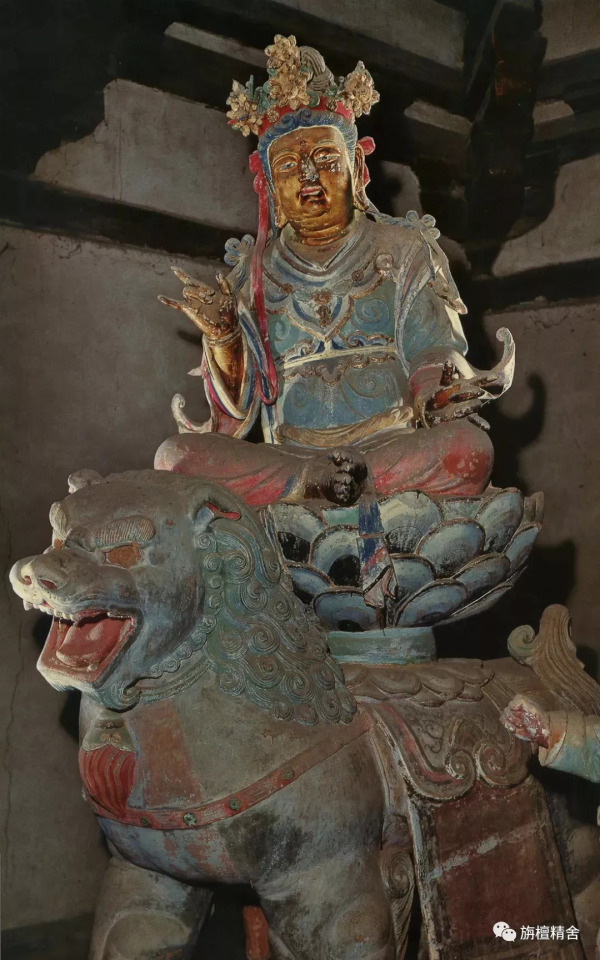
This is "Holy Old Monk Manjushri", a variant that I came across a few times while temple-touring, but couldn't find many good online pictures of. It seemed like a thing that was popular around Mt. Wutai, based on the "Buddha-palita met Old Man Manjushri" tale. Sometimes his BFF Samantabhadra is depicted as an old man too, for matching purposes.
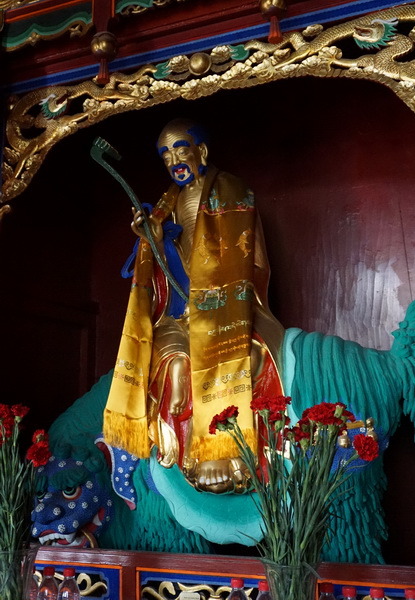
And this is Child Manjushri, with his five hair buns, often worshipped in an esoteric context. On Mt. Wutai, there are five major temples atop five peaks, each worshipping a different form of Manjushri, and the "middle peak" temple has a Child Manjushri in their main hall. Like, it's far from the most common variant, but neither is it this super obscure form that no longer enjoys active worship.
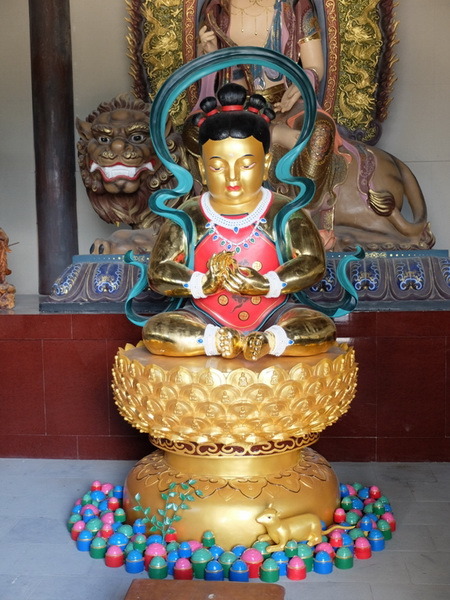
Lastly, just for fun: this is Yamantaka, a guardian deity/Wisdom King, who, in Tibetan Buddhism, is believed to be Manjushri's wrathful form.
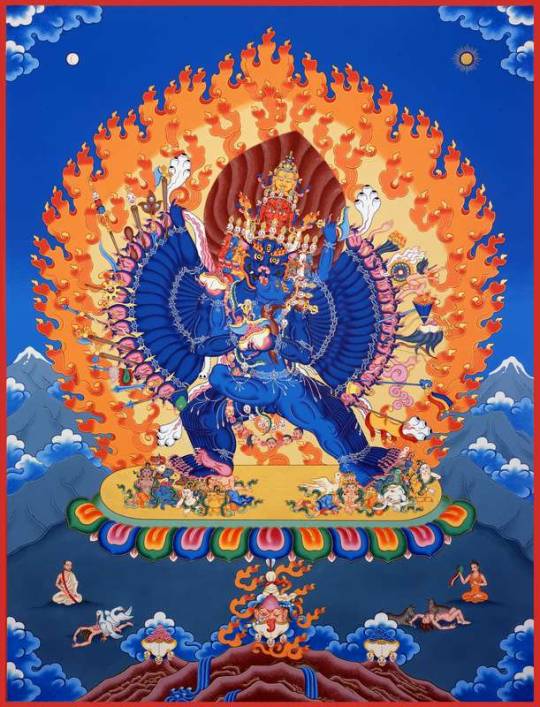
If you wouldn't call Manjushri "the eternal child Bodhisattva" just because he has a child form, why would you say Nezha is an eternal child when he, too, has both child and adult forms?
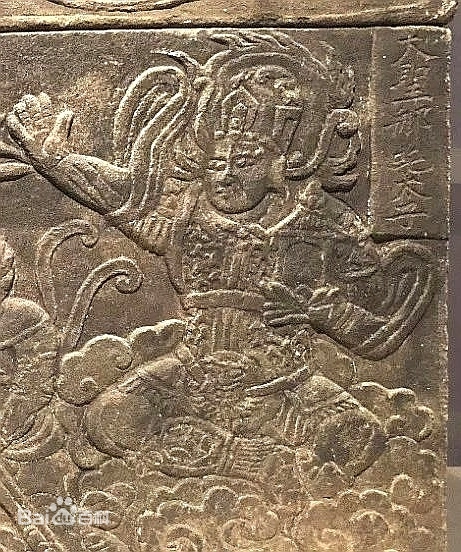
Even though Nezha's child form is vastly more popular and well-known than Child Manjushri, I think my point still stands: A deity is capable of having multiple manifestations, of varying ages and appearances, each fulfilling a particular function and niche——none of which is the "One True Form TM", just different clothes they wear based on occasions and audiences.
To stretch the analogy a little, Manjushri's child form is the formal dress he puts on before attending a religious event, while Nezha's child form is the lotus T-shirt he wears a lot while appearing on TV, to the point it becomes his most iconic attire.
This doesn't mean he only has a single shirt, for goodness sake, and using his child form as evidence for the "eternal child" claim is like saying Nezha's only allowed to wear that one shirt and nothing else.
#chinese mythology#chinese religion#buddhism#manjushri#bodhisattva#nezha#buddhist art#fandom discourse#lego monkie kid#...tagging lmk because where else would I see the “eternally 12” thing proliferate#this will be my only two cents on the topic#barring answering asks that are specifically about Nezha in FSYY/JTTW
155 notes
·
View notes
Text
April 12, Xi'an, China, Daci'en Temple/大慈恩寺 and the Giant Wild Goose Pagoda/大雁塔 (Part 1 - Temple and Architecture):

Daci'en Temple is famous in popular culture mainly for one reason: the monk Xuanzang/玄奘, or the real person who inspired the character of Tang Sanzang/唐三藏 (sometimes translated as "Tripitaka") in the novel Journey to the West/西游记. Xuanzang was in charge of Daci'en Temple after he returned to China in 645 AD from his journey throughout Central Asia and India. More on him later.
The temple is also known for two more things, first is its importance to Chinese Buddhism, as the temple is considered the cradle of the Consciousness-Only School (weishizong/唯识宗) and the Dharma Characteristics School (faxiangzong/法相宗)(both are part of Chinese Mahayana Buddhism), and second is the Giant Wild Goose Pagoda (built in 652 AD while Xuanzang was in charge of the temple).
The temple has been rebuilt over the years, and the current temple (excluding the pagoda) was mainly built in 1466, during Ming dynasty, thus the current temple consists of Ming-era architecture:


Drum and bell towers within the temple


Giant Wild Goose Pagoda in the distance

More pictures of the architecture. I have to say it's better preserved here than in other places so far...





Coming up to the Mahavira Hall/大雄宝殿 of the temple

As mentioned in the previous posts on Qinglong Temple, I avoided taking pictures of the Buddha statues as this is considered disrespectful. But because it's just hard to avoid including them in pictures of the architecture, the statues may be partially visible sometimes.


Approaching the Tushita Hall/兜率

More pics of the architecture, note the pattern on the windows, called chuangling/窗棂. This particular one is a "three-crossing"/三交 pattern, the highest grade of chuangling.
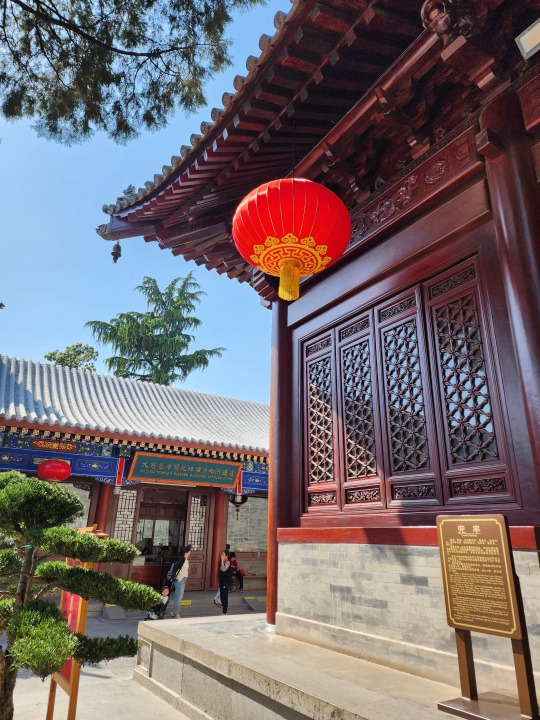

There were two visiting monks taking pictures of this relief behind Mahavira Hall, so it's probably okay to snap a picture of it. The interesting thing is the bian'e/匾额 above it, which says 人天欢喜 (right to left: "human and heaven rejoice together"). Usually it's "heaven" before "human" (天人), but here it's clearly "human" before "heaven".



The Guanyin Hall/观音殿. Guanyin is the Chinese name for Avalokitesvara. The smaller red lanterns are where visiters hang their wishes from:

And finally the Giant Wild Goose Pagoda, one of the landmarks of Xi'an. This pagoda was originally built to house all of the Buddhist texts and relics Xuanzang had brought back from India, and is the largest Tang-era brick pagoda remaining today. In Tang dynasty (618 - 907 AD), people who passed the imperial exams to become jinshi/进士 would tour around Chang'an on horseback with flowers in their hair and write poems before this pagoda, called "雁塔题名".
Before we entered the temple, I could hear a weird jingle-jangle from across the street, but it was only when we came up to the pagoda that I realized where the sound was coming from. There were bells hanging from every corner of every level of the pagoda, and they were pretty loud for their size.

Since it was pretty hot outside that day, to avoid possible heat stroke we didn't attempt to climb the pagoda (I don't think there's air conditioning inside considering that this pagoda is 1300+ years old.....). I think there were several important artifacts/relics inside? But I can find some pictures from online for part 3.



#2024 china#xi'an#china#daci'en temple#大慈恩寺#giant wild goose pagoda#大雁塔#xuanzang#玄奘#buddhist temple#chinese architecture#chinese history#mahayana buddhism#buddhism#architecture#history#culture
98 notes
·
View notes
Note
I think this is the first big chinese media that had wukong retire as buddha. Lego doesn’t count their lore is confusing.
So funny enough a friend @aerkame was telling me how this is the same company that made the Asura Online (2007) 斗战神 and how they could share similar lore as well! They gave me this Reddit picture that really helps explains it.

The reason that the game could be called "Black Myth" would be that immortality (and also enlightenment or Buddhahood) isn't what it seems at least in the game. The games kinda take a more Bio of Wukong kind of approach as more of an illusion for people in power to keep their status quo, rather than following the original myths such as heaven being good and yaoguai being evil it moreso treats it as if it two factions of equal merit fighting each other. Just that one is considered more 'acceptable' than the other than to humans and Yaoguai are actually just misunderstood and oppressed.
It does help Wukong's image of someone that fights against oppressive governments no matter what. Even though it is sad that immortality/enlightenment is a lie. But it does have the advantage of subverting the expectations of people familiar with the story (heaven good & demons bad) but I feel that Black Myth allows for more room to breathe with their characters as the yaoguai are allowed more complex backstories without changing too much of their canon. It feels more genuine in making them still their characters but making them just more sympathetic.
Anyway this is just me saying that I think I think Black Myth follows more of that kinda of storyline, hence rather than Wukong becoming somehow unenlightened that he was more misled into a false promise of Buddhahood from the start.
#(Please note I am only now watching a let'splay of the game so I'm not fully up to date)#sun wukong#anon ask#anonymous#anon#jttw#journey to the west#ask#xiyouji#black myth wukong#black myth#bmw#i mentioned bio of wukong cause that is there the edgy wukong fics really start to pic up#with like evil heaven and good yaoguai and sure depends on how good the writing is but it can really hit hard#immortal demon slayer is a good example of that as well
101 notes
·
View notes
Text
Explain the basic: Offerings
Desclaimer: Everything I will talk about is information that I got from books and sites online and even videos on YouTube. In my years of practice, I learned as much as I could out of curiosity and what works best for me. I suggest you do the same by learning as much as you can on your own (I will be here making posts teaching this kind of stuff) from multiple sources.
Offering to deities and entities in general is a practice found in many cultures and religions around the world. Every deity or entity that you make an offering for has its own symbol. For example, Apollo is the god of the sun; music, art, and poetry; writing something or singing for him can be offerings.

There are many religions that take on the act of offering as a sign of respect and devotion to that specific religion. Here are some examples:
Hinduism: Offerings (puja) often include fruits, flowers, incense, and food, placed before images of deities in temples or home altars.
Buddhism: Offerings may include candles, incense, flowers, and food, placed before statues of the Buddha and bodhisattvas.
Christianity: Candles, bread, and wine are common offerings, especially in the context of the Eucharist.
Shinto: Offerings of rice, sake, and other food items are made at shrines to honor kami (spirits or gods).
Paganism and Wicca: Offerings might include seasonal fruits, flowers, wine, and personal tokens, placed on altars dedicated to specific deities or nature spirits.
All these religions have common practices that we can see and see over time; all of those are not rules but more something you can do or not do. (Especially because no one has the same opportunities.)
Altars: A dedicated space where offerings are made. This can be a simple shelf at home or an elaborate structure in a temple.
Purity: Many traditions emphasize the importance of purity in the offerings, meaning they should be clean and handled with respect.
Timing: Offerings are often made at specific times, such as during festivals, holy days, or particular phases of the moon.
Intention: The mindset and intention behind the offering are crucial. It should be given with respect, devotion, and a pure heart.

These offerings can take various forms, each carrying its own significance and purpose. Here's an overview of the different types of offerings and the common practices associated with them:
Types of Offerings
Food and Drink:
Fruits, grains, and vegetables: Often used in offerings to symbolize abundance and gratitude.
Cooked meals: Specific dishes that are favored by the deity or entity.
Drinks: This can include water, wine, milk, or other beverages. In some traditions, alcoholic drinks like mead or sake are common.
Sweets and desserts: Cakes, candies, or other sweet treats, especially those that are traditional or culturally significant.
Flowers and Plants:
Fresh flowers: Often chosen for their beauty and fragrance. Certain flowers are associated with specific deities.
Herbs:: Sacred or medicinal herbs may be offered for their symbolic properties.
Incense and Aromatics:
incense: Burned to create a fragrant smoke that is believed to please the deities.
Essential oils: Used for anointing or in diffusers to create a sacred atmosphere.
Candles and Lights:
Candles: Lit to symbolize light, purity, and the presence of the divine.
Oil lamps: Used in many traditions, often with ghee or olive oil.
Objects and Symbols:
Statues or images: Placed on altars as representations of the deity or entity.
Jewelry or precious items: Offered as a sign of respect and devotion.
Money and Valuables:
Coins or currency: Offered in temples or shrines, sometimes used to support the upkeep of the place of worship.
Jewelry or precious items: Given as a form of sacrifice or in seeking favor.
Actions and Devotions:
Prayers and chants: Recited to honor the deity or entity.
Songs and music: Played or sung as a form of praise.
Dance: Performed in some cultures as an offering of movement and energy.

Conclusion
Offering to deities and entities is a deeply personal and culturally rich practice. It serves as a way to connect with the divine, show gratitude, seek blessings, and maintain a reciprocal relationship with the spiritual world. The specific items and practices may vary, but the underlying principles of respect, devotion, and intention remain consistent across different traditions.
#manifestation#manifesting#shifting methods#loa methods#manifestation method#manifesation#journal#spiritual development#explain the method#explained#witchcraft#witches#witchblr#witch community#witchcore#magick#witch aesthetic#witchy vibes#baby witch#witch#witchcraft books#witchcraft 101#pagan#spiritual journey#spirituality#spiritual awakening#spiritualgrowth#spiritual healing#meditation#witchcraft community
98 notes
·
View notes
Text
Elevate Your Spiritual Intentions with the Grace of the Buddha Statue
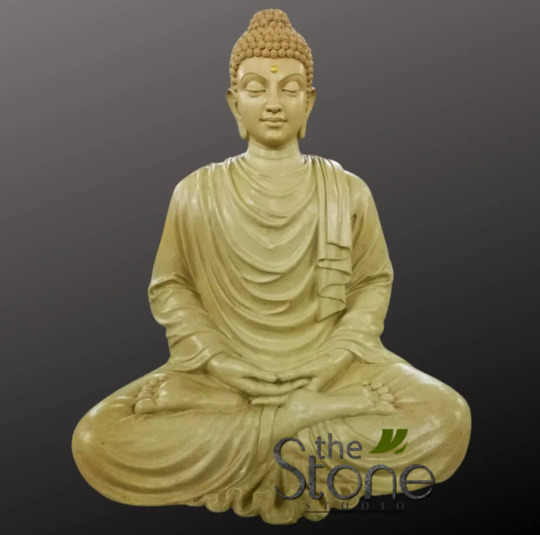
Fibre Buddha statues are capturing hearts as a dominating trend in both interior and outdoor decorating. These sculptures have been handcrafted by contemporary craftspeople using innovative techniques. The mix of lightness and durability is an intriguing element of this material. Extensive testing ensures not just authenticity but also long-term durability. Inviting these celestial forms into your surroundings brings mental peace and power over the realm of the mind.
Dissolve the Chains of Inner Attachments
Resilient against the harshest elements of the environment, the Fiber Buddha statue thrives outdoors with a splendid grace. It stands as a precious and distinct gift, a gesture of profound affection and blessings for those held dear. The gift's recipients will embrace this exceptional token with joy, cherishing it throughout their lives. Meanwhile, the sculptures themselves are a symphony of intricate details, enchanting the gaze of all who come into their presence.

FAQs:
Which Buddha statue invites home luck?
The happy Buddha and the respected Shakyamuni Buddha summarize the essence of prosperity.
Where does the Buddha statue find its home within a house?
Buddha's dynamic poses embody diverse meanings and intentions. The orientation shifts in harmony with the posture and gestures.
Which material befits the Buddha statue with utmost authenticity?
Stone Buddha statues hold the mantle of tradition and authenticity with grace.
4. How many manifestations of Buddha's essence are there?
Over a hundred poses depict each stage of Buddha's path, from beginning to end.
Infuse Your Landscape with a Remarkable Serenity

A Buddha statue shows that you are looking for a personification that arises elegance while matching your spiritual dedication. It repels negative energy and acts as a remedy for both inner and exterior ailments. Each piece is intricate, as if the creativity is breathing life into it. Furthermore, guests are driven to pause, their eyes drawn to the gorgeous appearance.
Aiding in the Creation of Sacred Space
If you want to improve your strength and raise your moral interests, a 3ft Buddha statue online is an excellent way to start. The stone studio is a haven of workmanship, with each piece filled with care and tenderness found nowhere else. These high-end products can be customised to fit your needs. What better way to change your home than with an exceptional statement of style?
0 notes
Text
Tamamizu Monogatari, a unique love story
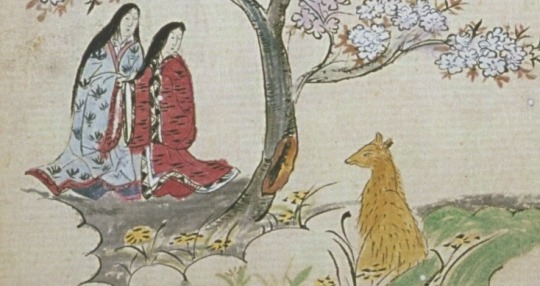
This article, unlike most of my recent longer pieces, was not planned in advance. I learned about the subject very recently, and instantly realized I absolutely have to introduce it to more people, the previously posted schedule be damned. The Tale of Tamamizu (玉水物語, Tamamizu Monogatari) is a story about a fox turning into a human, but a rather unconventional one, filled with an unusual degree of sympathy for the eponymous protagonist and focused on a rather unique relationship. In addition to summarizing it in detail and explaining the possible inspirations behind it, I will also try to explain why the tale found a new life on social media as a, broadly speaking, lgbt narrative, and why I think there is a compelling case to be made for such an interpretation. Unless stated otherwise, all images used through the article are taken from the Kyoto University Rare Materials Digital Archive, on whose website you can view scans of the original Tamamizu Monogatari.
The Tale of Tamamizu, also known as The Contest of Autumn Leaves (Momiji Awase) is an example of otogi-zōshi, illustrated prose narrative. The story was presumably originally composed in the Muromachi period (1335-1573), and it survives in multiple copies dated either to the early Edo period or to the end of the Japanese “middle ages” directly preceding it. The identity of the author (or authors) is unknown. Despite its apparent popularity in the past, it seems no major studies of the tale of Tamamizu have ever been conducted. A streamlined translation (or rather an extensive summary) was published online by Kyoto University Library in 2001 and can be accessed here. In 2018, a full translation, as well as a brief introduction, were prepared for the anthology Monsters, Animals, and Other Worlds. A Collection of Short Medieval Japanese Tales. Still, it doesn't seem either sparked all that much interest in Tamamizu, despite the story’s obvious modern appeal. Since the tale of Tamamizu is not well known, I will start with a detailed summary. I am consistently using female pronouns for Tamamizu after she transforms, as does the older translation. The other English translation switches between female and male pronouns. I will explain in the final paragraph of the article why I made the decision to follow the former. The Tale of Tamamizu The story of Tamamizu does not start with the eponymous character, but rather with a certain mr. Takayanagi from Toba. He is troubled, as while he is already 30, he has no children. He decides the only choice is to pray to gods and buddhas. This actually does work, and his wife becomes pregnant, and after the expected period gives birth to a daughter. She doesn’t get a name at any point in the story. The girl’s birth is followed by a timeskip. As we learn, she was distinguished by twenty five features associated with beauty. This is apparently a reference to the belief that a buddha possessed thirty two specific physical traits; the number might have been altered to twenty five because of a popular group of twenty five bodhisattvas associated with Amida. By the time she reached the age of fifteen or so, she also developed great skill in composing poetry in both Japanese and Chinese. Her parents at some point decided that it would be ideal to send her to serve in the emperor’s court in the future. The girl spends most of the time in awe of the blooming of flowers, the wind and other similar phenomena, as one would expect from a literary character of similar status. She maintains her own flower garden, and spends much of her time there.

On one of the days when she visited it alongside her friend Tsukisae, the daughter of her nurse, she caught the attention of a fox. The fox is, at this point in time, not yet Tamamizu. He wishes he could introduce himself to the girl. He considers the standard method - transforming into a nobleman - but he realizes this would likely sadden the girl’s parents, and would tarnish her reputation. He falls into despair. It does not exactly help that his attempts at visiting the garden again end up poorly - on the way there, he gets pelted with stones and then, after trying again, shot with an arrow. Still, he continued to hope to meet with the girl. An opportunity finally arose through a lucky coincidence. Another family living in the same area had multiple sons, but no daughters, much to the parents chagrin. They loudly lamented that they wished they had at least one girl among the children. The fox overheard that and realized it might be an opportunity. He transformed himself into a teenage girl (curiously, the story specifically puts her at the exact same age as the unnamed second protagonist), and enters their house. She explains that she is an orphan, and while passing by she overheard the family’s woes. She offers to become their daughter. The couple instantly agrees.

The fox spends some time living with her adoptive family, though she gets sad easily and keeps bursting into tears. After some time, they offer that they will find her a husband in due time, but she reacts to that poorly, and eventually suggests she would prefer to become the servant of a noble lady. Her adoptive mother agrees this isn’t a bad idea, and reveals that her younger sister is a lady-in-waiting of the daughter of a local noble, mr. Takayanagi. She suggests the fox could become her attendant too. She is overjoyed at this prospect, and is soon sent to Takayanagi’s mansion to meet with his daughter. The girl receives her new attendant warmly, and gives her a nickname, Tamamizu-no-mae (Tamamizu for short). They get along really well, and Tamamizu gets to partake in her various activities, serves her food and drinks, and even sleeps in the same bed (Tsukisae does too, though). While Tamamizu does remarkably well as a human, some of her fox habits remain. Most notably, she is really afraid of dogs. Her lady sympathizes with her plight, and actually bans dogs from her household. This is a much welcome change from Tamamizu’s point of view, though apparently some other members of the staff start to view her as a coward because of this, and simultaneously resent her closeness with the girl. The bond between Tamamizu and the girl reaches a new level when on a moonlight night they spontaneously compose a poem together. It deals with longing. We are told it was followed up by multiple other poems, which are not quoted in the story. Eventually the girl gets tired and heads to her room. However, Tamamizu remains outside gazing at the moon and eventually starts crying, unsure what fate awaits her. Tsukisae, who was inside all along, actually becomes concerned about Tamamizu, and says she feels sorry for her, correctly identifying the cause of her sorrow as love for an unidentified party. She shares her thoughts with their lady (in the form of a poem, of course). The latter summons Tamamizu inside, and soon all three go to bed together. Tamamizu is still overwhelmed by her feelings and can’t fall asleep, though. Tamamizu continues to serve the girl for the next three years. She also remains in touch with her adoptive mother, who sends her letters and new clothes every now and then. One day, many visitors arrived in the house for a friendly competition. The winner will be the person with the most beautiful collection of autumn leaves. Tamamizu decides she must find some for her mistress to give her an advantage. To accomplish that, at night for the first time in years she turns back into a fox, and leaves to visit her siblings. Not the adoptive ones, though. As it turns out, she has two fox brothers, one younger and one older. She actually hasn’t visited them in so long they assumed she died and held funerary services for her in the meanwhile. They are overjoyed to learn that is not the case, and after learning about her current life agree to help her with finding unique leaves. She tells them to leave them on the veranda of her mistress’ mansion, and reassures them it’s safe for foxes to be there thanks to the earlier decision to not allow dogs on the premises. After the visit Tamamizu returns home in her human form. Tsukisae and her mistress ask her where she has been, and she jokes about meeting with a “dubious fellow” (which, to be fair, is not even a lie, given the typical folkloric portrayal of foxes). This in turn leads to more jokes, revolving around Tamamizu no longer thinking about her mistress. She feels distressed by this suggestion.
Tamamizu’s brothers in the meanwhile succeed in their search for thrilling leaves. One of them found a branch with five-colored leaves decorated with the Lotus Sutra (as you probably know, one of the main religious texts in the Mahayana Buddhist tradition). Tamamizu is overjoyed, and instantly brings them to her mistress. The girl received plenty of leaves from other people in the meanwhile, but all of them pale in comparison. She is so happy about the gift that she requests Tamamizu to also write poems meant to accompany the presentation of the collection. She protests that she is unsuitable, but eventually accepts this honor and gets down to work. The parents of the girl came along to watch her write, and both of them concluded she is exceptionally skilled. She ends up providing five poems, one for each color of leaves gathered. They are subsequently combined by these the girl wrote herself.
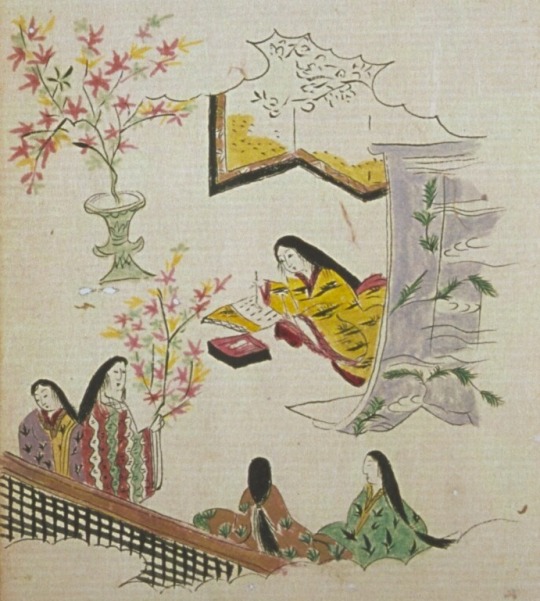
Obviously, the main characters’ joint entry wins the competition. This grants the girl such fame that the emperor declares she should come to his court. Since her father is not affluent enough to pay for traveling there, he bestows additional estates upon him to make that possible. Even Tamamizu gets her own estate, Kakuta in Settsu Province. However, she decides it will be for the best to give it to her adoptive parents. Shortly after that, Tamamizu’s adoptive mother falls sick. She leaves her mistress to attend to her, but it did not help much and her condition kept worsening. Therefore, her stay had to be extended over and over again. This predicament worries her mistress, who sends her a letter to let her know that it is boring and gloomy without her around, and implores her to return as soon as her mother’s condition improves. Tsukisae is similarly concerned. Both of them voice their concerns through poems, which at this point should not be surprising for the reader.
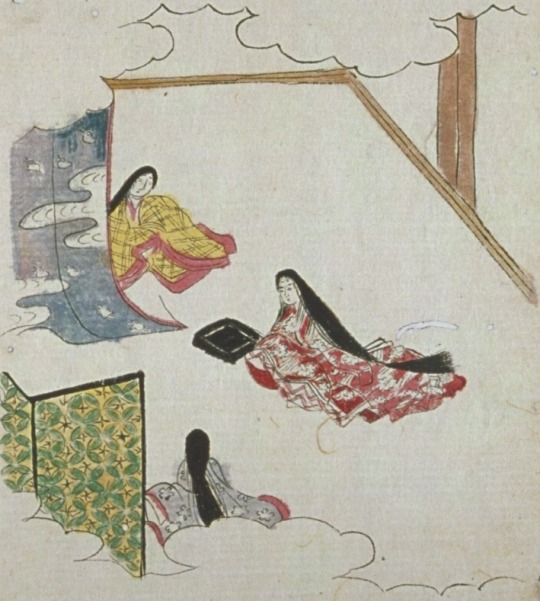
Tamamizu of course appreciates these displays of sympathy, but she cannot return, so in response she only reassures both of them that she will meet with them again as soon as possible. Shortly after that, the mother’s condition worsened yet again. The entire family laments through the entire day, but eventually everyone manages to fall asleep - save for Tamamizu. In the middle of the night Tamamizu notices that an old, hairless fox entered the house. She quickly realizes that he was her paternal uncle (a fox uncle, that is. Not a relative of her adoptive parents). The illness was his doing, as she quickly realizes. Tamamizu requests him to leave her adoptive mother alone. However, the old fox says he cannot do that, as the illness is his act of revenge against her family, since her father killed his child. He concluded it is only right to make his daughter sick so that she dies too.
Tamamizu admits that this makes sense in theory, but she points out that acting upon desire for revenge will only bring bad karma, and bad karma from previous lives is why both of them were born as foxes in the first place. She offers the old fox a crash course in Buddhist ethics, and warns him that accumulating even more bad karma might lead to someone eventually killing him too, and to yet more rebirths in one of the three realms which are best to avoid (animals, hungry spirits, hell).
The old fox notes following buddhas is for humans, not for those born in other realms of rebirth (he’s not entirely wrong, humans are generally held to be in the optimal condition to seek enlightenment; animals must follow instinct and thus end up accumulating bad karma, devas are to preoccupied with celestial bliss), but eventually he relents and agrees that it would be wrong to kill the woman because of the actions of her father. He concludes that it would not even make him feel better, since his child would remain dead. He tells Tamamizu that evidently he was able to meet her because of good karma acquired in a past life, asks her to pray for his deceased child, and leaves, announcing he shall become a monk reciting nenbutsu from now on. Tamamizu did what he asked for, and even performed a funerary service for her late cousin. With the problem solved, her adoptive mother returned to good health. She was therefore free to meet with her mistress again. She was elevated to the rank of chujo no kimi, the foremost among servants. However, despite her mistress’ best efforts to make her feel appreciated, she was suffering from persistent bouts of melancholy. She wished she could confess her love and consummate the relationship, but she concluded that since she kept her identity secret for so long, it would be no longer possible to reveal it without losing the acceptance of the girl. She decides she must disappear. However, before that she prepares a long poem explaining her predicament.

She placed it in a box, and gave it to her mistress, explaining that it should only be opened if something happens to her. She then broke down in tears.
Tamamizu’s mistress does not fully understand what is happening, and asks if she perhaps is worried about their planned relocation to the imperial court. However, Tamamizu denies that and guarantees she will accompany her on the journey there. Her mistress starts crying too, and says she has hoped they will always be together. Shortly after, the day of the journey came. Tamamizu’s mistress and mr. Takayanagi, now recognized as a lord, were certain that she went with them, but as soon as they reached their destination it turned out she was nowhere to be found. Days upon days of grieving followed. Eventually, the girl realized that she had no choice but to open the box. From the poem contained within, she learned everything about Tamamizu, from the day they first met all the way up to the disappearance. It explained how she hoped to protect her mistress through her current life and beyond, but had to give up after realizing it was all in vain. In the final words of the poem, she firmly refers to her with the name she was given by the girl - Tamamizu.
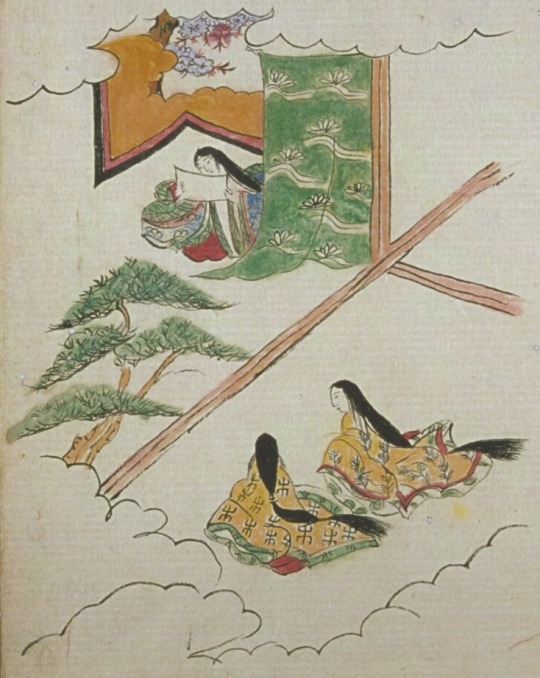
The poem moves her deeply, but the story does not have a happy ending - we never learn what happened to Tamamizu afterwards.
Tamamizu’s forerunners
It is agreed that much like the considerably more famous Tamamo no Mae, Tamamizu in part depends on earlier Chinese literature about foxes. Not exactly on the same sort of stories, though - she is not exactly a malevolent seductress, to put it lightly. The key to finding her forerunners is the scene in the beginning when the still nameless fox considers transforming into a male suitor at first, before settling on the form of a female attendant, and the erudition she displays through the story. An argument can be made that this is conscious engagement with a very specific type of older fox story, largely forgotten today. In Tang China, fox stories enjoyed considerable popularity. You may remember that I mentioned this in passing a few months ago in another fox-themed article. One of the genres popular at the time was focused on fox suitors. There are many stories like that, but they largely follow a similar plot: a male fox falls in love with a human girl, takes the form of a dashing literatus and requests marriage. The girl’s family rejects the proposal, as despite charm and erudition the fox is ultimately an outsider with no family, and doesn’t depend on the well established institution of matchmaking. Afterwards, he typically tries to win the girl over with some sort of trick, and fails in the process, thus meeting his demise when his real identity is inevitably exposed.
In some cases, twists are introduced and the fox is effectively exploited by the family: for example, in the story about a certain mr. Hu (a common surname which is a homonym for the word for fox) and the granddaughter of the official Li Yuangong, the Li family agrees for the girl to be taught by the fox, and even asks him for advice on various matters, just to kill him once he outlived his usefulness.
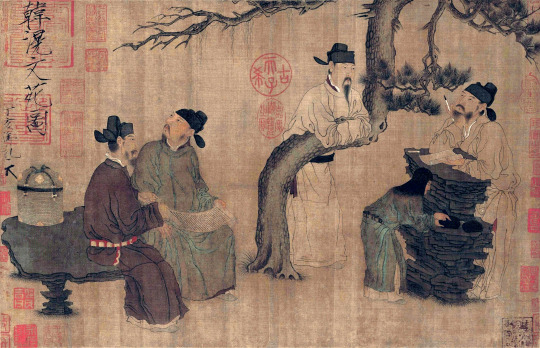
Zhou Wenju's painting A Literary Garden (文苑图, Wenyuantu), showing a group of discouring Tang literati (wikimedia commons)
Many literati came from humble backgrounds, and only attained high positions thanks to success in the imperial examinations. However, their advances were often frowned upon by nobles, who saw them as upstarts. Therefore, faking a more notable origin was widespread to secure a better position in the high strata of society. All of this is reflected in the stories of the fox suitors. Xiaofei Kang, who wrote my favorite monograph about Chinese fox beliefs, notes that the stories might have effectively been a way to cope with everyday anxieties. In other words, perhaps the fox self insert fails so that the real person sharing his precarious status can succeed.
Another aspect of the Tale of Tamamizu which offers a clue about its origins is the focus on Buddhism, and its role in the lives of non-humans in particular. Tamamizu evidently attains a considerable familiarity with Buddhist doctrine, to the point the old fox basically seems to perceive her as thinking more like a human than a fox. Evidently, she doesn’t think being an animal should prevent one from seeking good karma. This seems to reflect a medieval Buddhist phenomenon. Roughly from the Insei period (1086-1185) up to the eighteenth century, and especially between the twelfth and fourteenth centuries, the dominant esoteric schools of Buddhism propagated the doctrine of hongaku (本覺), “original enlightenment”. This idea originates in an earlier Buddhis text, Awakening of Faith in the Mahāyāna. According to proponents of this idea all living beings, even plants, possessed an innate “Buddha nature”, as did natural features like mountains. They were innately capable of attaining enlightenment, or innately enlightened outright. Religion influences art, so it has been argued that the spread of new stories about animals behaving like people in the Muromachi period had a distinctly Buddhist dimension.
The modern reception of Tamamizu
Despite the fascinating themes of the story of Tamamizu, it only found a greater degree of modern recognition in 2019, outside of academic circles at that. I'm surprised it took so long, since when you think about it, the sensibilities of the author indeed seem surprisingly modern. The narrator even reassures us Tamamizu’s human form is the same age as the object of her affection, anticipating what sorts of shipping discourse could arise 700 years later. Anyway, in 2019 a fragment of the story was the subject of one of the classical Japanese literature questions from the National Center Test for University Admissions, a standardized university entrance exam held across Japan each January from 1990 to 2020. This obviously exposed an enormous number of people to it, not just exam-takers. Following this event, a Tamamizu fad seemingly swept social media and pixiv (curiously, there’s a single piece of art there which predates the phenomenon by six years; op actually updated the description in 2019 to say they are happy more people learned about the story). There’s even a Tamamizu Monogatari tag on Dynasty Scans as a result. It’s worth pointing out the wikipedia entry of the story was written in 2019 as well. Most curiously apparently a research project focused on Tamamizu, Kahoko Iguru’s Border transgression between species and gender as observed in “Tamamizu Monogatari”, received a grant in the same year too (source; more info here). It doesn’t seem the results have been published yet. I will keep you updated if that changes, obviously. I am actually surprised I didn’t notice the Tamamizu phenomenon back then, even though 2019 Antonia was distinctly more terminally online than 2023 Antonia is. It’s worth noting that Tamamizu’s fame didn’t fade away. The online following the story gained was referenced in an Asahi Shimbun article a year later. A quick survey of social media will show you there are people still talking about Tamamizu today. People who aren’t me, that is. What made Tamamizu so unexpectedly popular - arguably more than the story has been in the past few centuries - in recent years? Most of the linked sources relatively neutrally state that people perceive it as a “unique love story”. Social media posts are often considerably more direct: for many people, the appeal lies in the realization the Tale of Tamamizu is probably the closest to a lesbian love story in the entire corpus of medieval Japanese literature. I won’t deny this is in no small part its appeal for me too. Note this is not an universal sentiment by any means, though. It is difficult to tell if this was the intent of the medieval author(s), of course. It is obviously impossible to deny that women attracted to women existed in medieval Japan, as is the case in every society since the dawn of history. However, they left little, if any, trace in textual sources. As pointed out by Bernard Faure, in Japan in the past as in many other historical societies “sexuality without men is properly unthinkable” and therefore received no coverage. While there is plenty of Japanese Buddhist literature dealing with male homosexuality (trust me though, you do not want to read it; I’ve included a brief explanation why in the bibliography), there is basically nothing when it comes to women. The only possible exception is what some authors argue might be a medieval depiction of a lesbian couple in Tengu Zōshi, a work I plan to discuss in more detail next month, but note that this would be only an example of condemnation, since this work is a religious polemic dealing with vices of the clergy.

The supposed lesbian couple from Tengu Zōshi; image from Haruko Wakayabashi's The Seven Tengu Scrolls: Evil and the Rhetoric of Legitimacy in Medieval Japanese Buddhism; reproduced here for educational purposes only.
This sort of absence of evidence is a recurring pattern through history - you might recall my own attempts to find out what Bronze Age Mesopotamian sources have to say on this matter. Before the Meiji period, when the term dōseiai (同性愛) was coined as a calque of Charles Gilbert Chaddok’s freshly invented label “homosexual”, there wasn’t even a distinct Japanese term which could be applied to lesbian relationships. Once again, this does not indicate this phenomenon did not exist - but it does indicate that due to extreme levels of sexism in the perception of both sexuality and relationships it was difficult to even imagine for the average author. Faure suggests the prevailing attitude was presumably similar as in continental Buddhism, in which lesbian love “was at best perceived as a poor imitation of heterosexual relations—or a preparation for them—and as such condemned” at least in monastic rules. To put it bluntly, only penetrative sex was regarded as real.
And yet, in spite of this, I do not think it is wrong to wonder if perhaps what seems like subtext to a modern reader is actually intentional. This is obviously a reach, but given that relationships between women - not even romantic ones - were historically not a major concern of most authors, I would argue it is not impossible that a work which revolves virtually entirely around the relationships between female characters was written by a woman. Perhaps a woman romantically interested in other women, even. Even more boldly, I’d ponder if perhaps the ambiguous gender of the fox before transformation was meant to make the romance palatable to general audiences. Note that while foxes transforming is a mainstay of both Japanese and Chinese literature, the change of gender is actually quite uncommon in such stories, making this single reference all the more unusual. Granted, gender change is hardly a major focus in the story of Tamamizu. The only real indication the fox is male is the decision to take a male human form at first, but beyond that, things get muddy to the point the matter of gender in the story evidently warranted an actual study, as I pointed out earlier. As you’ve noticed, this matter was approached in different ways by translators too. I personally think the most important factor is the fact Tamamizu refers to herself with this name in the final poem. This name is intimately tied to the distinctly female identity she took. Whoever she was in the beginning, by the end of the story she is clearly Tamamizu. If one felt particularly bold a case perhaps even be made that Tamamizu can be read as a trans woman based on this, perhaps. I think simply disregarding the brief reference to a male form is valid too, though. Even if these arguments were to be refuted fully, I would argue that there is a further reason why at the very least reinterpreting the story as dealing with a gay relationship is not against the spirit of the original work. As I outlined, the tale of Tamamizu seems to draw inspiration from a very specific genre of fox stories, in which foxes are essentially a metaphor for people seeking relationships which were frowned upon. Obviously, the fact that Tamamizu is not a human by default makes any relationship she would be involved in somewhat unusual and frowned upon, but that does not assign a different metaphorical meaning to her struggle. Is Tamamizu even really fully a fox and not a human at all by the time she writes the confession of her love, though? The old fox seems to basically dispute if she still thinks like an animal. We also know that she maintained her human form for so long her biological relatives assumed she had passed away. She also found acceptance of virtually every single human character in the story - save for herself, that is. It’s also not like it’s hard to reinterpret her struggle specifically with the inability to consummate the relationship through the lens of the medieval Buddhist views of female sexuality, rather than through the lens of the general view that relationships between human and transformed foxes were doomed to failure. To paraphrase Cynthia Eller’s evergreen quote about futile search for nonexistent matriarchal prehistory in ancient texts, I do not think an invented wlw past can give anyone a future, but at the same time I do not think it means we should conclude that nobody ever had similar experiences in the past, or that we can relate with works even in ways their authors did not intend. For this reason, I would ultimately argue in favor of embracing the Tale of Tamamizu as a narrative which can be read as a lesbian love story.
Bibliography
Bernard Faure, The Red Thread. Buddhist Approaches to Sexuality (please note: read this book very cautiously since multiple content warnings apply. Faure is a remarkably progressive author, so it’s not about his personal attitude or anything. The problem is that it is not possible to deny much of the Japanese Buddhist discourse about homosexuality had little to do with modern notion of gay relationships, and essentially amounts to explaining when exploitation of children is a pious act)
Rania Huntington, Alien Kind. Foxes and Late Imperial Chinese Narrative (some sort of explicit content warning applies here too, though mostly because some of the discussed works are trashy Qing period erotica. More funny than anything.)
Xiaofei Kang, The Cult of the Fox: Power, Gender, and Popular Religion in Late Imperial and Modern China
Keller Kimbrough and Haruo Shirane (eds.), Monsters, Animals, and Other Worlds. A Collection of Short Medieval Japanese Tales
Jacqueline Stone, Medieval Tendai hongaku thought and the new Kamakura Buddhism: A reconsideration
227 notes
·
View notes
Text

"Buddha Sheltered by the Serpent King Muchalinda" (11th/12th century) (image courtesy the Art Institute of Chicago)
12 notes
·
View notes
Text
Vividly Colored Imagination - EP

Characters — ✈︎ Akuta, Kiroku, Nanaki, Muneuji, Ushio, Sakujiro

Location: HAMA Tours Office Floor
Kaede: Everyone! I have good news!
Producer-san watched the tour the other day and asked if Kiroku-kun would want to display the okiagari doll from the live painting in the Kanazawa Art Museumーー
…Huh? The Day Squad was here just a second ago, weren’t they?
Sakujiro: It appears they were taking turns leaving the room at different times, and none of them have come back yet.
Kaede: They’re clearly skipping together, aren’t they!?
Sakujiro: Well, let us allow it, just for today.
Kaede: … I guess so.
Sakujiro: According to the young master, there have been an endless number of inquiries asking if HAMA Tours had any tours in Kanazawa.
Kaede: That’s amazing…!
Sakujiro: The collaboration seems to be a great success.
Kaede: Yes, everyone worked really hard on it…!

Kiroku: (I got told to leave the office and meet everyone out back… I wonder… where everyone is…)
Ah… Nanamegiーー

Nanaki: ………
Kiroku: (He’s holding something in his hand… and looking at it…?)
Nanaki: (I’m so happy that I got some feedback from Chief after the live show was over…)
(Of course I’m happy to receive comments online too, but it really does feel different when it’s coming from someone special to you.)
(And when that person… is someone you love… it feels even more special…)
Akuta: Yo! I got the special things.
Kiroku: Ah…!
Akuta: Where’s Nanaki?
Kiroku: O-Over there…
Nanaki: Sorry to make you wait.
Kiroku: !
Nanaki: What?
Kiroku: Nothing…
(I wonder… what he was looking at…?)
(One day, if I get the chance… I wonder if it’d be okay… to ask him about it… like he asks me…)
Nanaki: (That was close… If they saw me looking at the business card I got from Chief, it’d be so over…)
Muneuji: However… I do wonder if it was a good idea for us to sneak out like that. It’s still during working hours.
Akuta: But look, hasn’t the thought crossed your mind at least once since joining? I had to do it before I forget about it again!
Ushio: Yeah yeah. We’re still minors, yet we’re working way too much. Breaks are a part of a job too.
Nanaki: Let’s just leave it at that.
Akuta: Well theeen, cheers, to the success of Kiroku and Nanaki’s feature tour!
Ushio: Wait, this is just tea. We should at least have juice?
Muneuji: I felt a special connection to them because they were selling Kaga Boucha tea in plastic bottles. [1]
Nanaki: About the tour, did you guys see the student council president and Gannosuke-san at the tour too?
Muneuji: Indeed. Gannosuke-san drew very prominent eyelashes on an okiagari doll and made a hologram of it.
Akuta: It looked identical to the okiagari doll Ushio drew!
Ushio: Can you stop bringing that up?
Akuta: Hey hey, you think so too, right Rouzel?
Ushio: Rouzel?
Kiroku: ………

Rouzel: Myself and the others couldn’t get a good look since we were on the stage together with Kiroku!
Pinfu: Tell me quickly if there was a funny looking doll like that next time〜!
Muneuji: Hm, what on earth are those?
Kiroku: My… friends…
Nanaki: Yeah, Dewawa talks exactly like Ushio does
Ushio: Hah? Dewa…?
Dewawa: Hey, Nanaki. Were you not taught in school to add “san” when you’re referring to a stranger?
Nanaki: M-My bad.
Dewawa: What, are you some sorta pushover too?
Rouzel: Mister Nanaki was joking, Dewawa, joking!
Ushio: Hmmm.
Kiroku: ………!
(Is he gonna… make fun ofーー)

Ushio: So that’s how you’re set up huh, Buddha Statue? Interesting.
That’s a cliche I haven’t seen in a while, but it’s not a bad one.
Kiroku: …Nn…?
(He didn’t… badmouth… me…?)

Akuta: Ah!!
Ushio: W-What.
Akuta: I forgot to say something important.
Nanaki. That HosLive song sounded so much more like Kiroku than the first one we heard.
Nanaki: ……!
Thank you. Akuta said something that helped me out with that before.
Akuta: I did? What’d I say?
Nanaki: ……It’s a secret.
Akuta: You’re still saying that!?
Muneuji: But it’s true. That song was truly amazing. I want to hear it again.
Nanaki: Then, let’s play it.

Akuta: Here here. That sounded so good.
Kiroku: Silence…
Muneuji: Have you reached enlightenment?
Akuta: Kiroku, you’ve been listening to it while drawing a lot more recently right? You’re always so silent when listening to it.
Kiroku: Aah… I became a… fan of… unlove-sensei.
Nanaki: I said to stop calling me Sensei.
Akuta: What if I called everyone else Sensei so it cancels out?
Ushio: Your line of thinking makes no sense.
Muneuji: If you aren’t satisfied with Kurama-sensei… Then how about Professor Uu-chan?
Ushio: Hey Muu-chan, you know that’s not what I meant.
Akuta: Ohh then, I’m Dr. Isotake!
Nanaki: Hahaha! Doctor he said…
Kiroku: Heh…
Ushio: Oh, Buddha Statue laughed. Rare.
Akuta: Really? He laughs a lot! Right?

Kiroku: …………
Nanaki: Yeah. He laughs a lot when he’s in front of me.
Ushio: Uwah… You really did switch up, didn't you.
Muneuji: Switched up? From who?
Nanaki: That’sー Kiroku doesn’t laugh in front of you ‘cuz you’re like that! You aren’t funny!
Ushio: Hah?
Nanaki: What?
Akuta: Stop it! Don’t fight over my Kirokuー!
Nanaki & Ushio: We’re not fighting.
Muneuji: And he’s not your Kinugawa.
Kiroku: Hehe…
(I never imagined myself skipping with people and… Being able to chat like this until now…)
Today too…
Breathes in… Breathes out…
Taking a deep breath… feels… good…
Previous — ✈︎ Masterlist
Notes — ✈︎
I’m not too sure on what tea this is (<-- doesn’t like tea) but from what im seeing, it’s not typically sold in bottles so he might be like . this is my only chance to get this…! And bought a bunch LMFAO
#kfkr1ze#18trip#18trip translation#vividly colored imagination#nanaki nanamegi#ushio kurama#kinugawa kiroku#muneuji kaguya#akuta isotake#sakujiro karigane
8 notes
·
View notes
Text
Where can I buy the Buddha bronze statue online in India?
If you're searching for an authentic buy Buddha statue online to purchase online in India, Royaloak is the perfect destination. With their vast selection and commitment to quality, you can find a remarkable Buddha statue that resonates with your spiritual journey.
Royaloak offers an impressive range of Buddha bronze statues, each meticulously crafted by skilled artisans. These statues are known for their exquisite detailing, capturing the essence of Buddha's teachings and radiating a sense of serenity and wisdom. Whether you're looking for a seated Buddha, a standing Buddha, or a specific mudra (hand gesture), Royaloak has a diverse collection to choose from.

When you shop for a Buddha bronze statue at Royaloak's online store in India, you can trust that you'll receive an authentic and high-quality piece. The statues are made using traditional techniques and premium materials, ensuring their longevity and aesthetic appeal.
With Royaloak's user-friendly website, you can easily navigate through the selection, explore different styles and sizes, and make an informed decision. Once you've chosen your ideal Buddha bronze statue, simply add it to your cart, proceed to checkout, and experience the convenience of secure online payment and prompt doorstep delivery.
By bringing a Buddha bronze statue into your home, you invite a sense of peace and enlightenment. These statues serve as a visual reminder of mindfulness and the path to inner harmony. Discover the perfect Buddha bronze statue for your spiritual practice or home decor at Royaloak, and let its presence inspire and uplift you on your journey.
0 notes